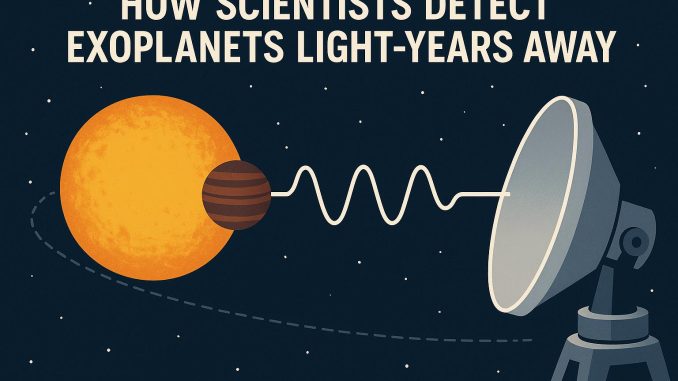
Understanding Exoplanet Detection
The detection of exoplanets, which are planets orbiting stars beyond our solar system, has become a remarkable field of study that bridges astronomy with cutting-edge technology. This fascinating domain has seen significant advancements over the past few decades, with scientists pioneering a variety of sophisticated techniques to identify and understand these distant worlds. As a result, our comprehension of the universe has been significantly enhanced, allowing us to explore the possibilities of life beyond Earth and understand more about the cosmic environment around us.
Transit Photometry
One of the most prevalent and successful methods for detecting exoplanets is transit photometry. This approach entails monitoring the light emitted by stars to identify periodic dips in brightness. The basic concept involves an exoplanet passing in front of its host star relative to our line of sight from Earth, effectively blocking a fraction of the star’s light, an occurrence known as a transit.
Through meticulous measurement of these transits, scientists can gather vital data regarding the planet’s size and the time it takes to orbit its star, known as the orbital period. This method has been instrumental in discovering numerous exoplanets. Key missions leveraging transit photometry include NASA’s Kepler Mission and the Transiting Exoplanet Survey Satellite (TESS), both of which have contributed to the discovery of thousands of such celestial bodies. The wealth of information gained from these missions continues to be a cornerstone in our understanding of exoplanetary systems.
Radial Velocity Method
Another crucial technique in the field of exoplanet detection is the radial velocity method, sometimes referred to as the Doppler method. This method focuses on detecting changes in a star’s velocity, which occur due to the gravitational pull exerted by an orbiting planet. As a planet orbits its star, it causes the star to experience a slight wobble. This motion results in shifts in the star’s light spectrum due to the Doppler effect, leading to spectral changes towards red or blue wavelengths.
By carefully analyzing these spectral shifts, astronomers can accurately determine the planet’s mass and its orbital characteristics. Instruments such as the High Accuracy Radial velocity Planet Searcher (HARPS) spectrograph, installed on the European Southern Observatory’s 3.6-meter telescope in Chile, have been particularly effective in utilizing this technique. The radial velocity method has provided a wealth of information about exoplanetary masses and orbits, complementing the data obtained through transit photometry.
Direct Imaging
While technologically challenging, direct imaging is a unique method that involves capturing actual images of exoplanets by mitigating the overwhelming brightness of the host star. This is achieved using specially designed telescopes equipped with advanced optics and techniques such as coronagraphs, which enable scientists to isolate and photograph these distant worlds.
Direct imaging, though less frequently employed due to its complexity, offers invaluable insights into a planet’s atmosphere and surface conditions. By obtaining direct images, astronomers can glean information about the exoplanet’s temperature, atmospheric composition, and potential weather patterns. As technology continues to advance, direct imaging holds the promise of significantly enriching our understanding of exoplanetary environments.
Gravitational Microlensing
Another intriguing and innovative method for detecting exoplanets is gravitational microlensing. This technique hinges on the gravitational field of a foreground star acting as a natural lens. When a star hosting a planet aligns with another, more distant star from our viewpoint, the gravitational lensing effect caused by the foreground star can magnify and reveal the presence of the planet.
Gravitational microlensing is particularly well-suited for detecting exoplanets that are located at greater distances from their host stars, as well as those orbiting stars at considerable distances from Earth. Organizations such as the Microlensing Observations in Astrophysics (MOA) project employ this approach to expand our comprehension of planetary systems further out in the galaxy.
The Future of Exoplanet Detection
As technology and methodologies continue to evolve, the capabilities for detecting and studying exoplanets are expected to improve substantially. One of the upcoming missions that promises to revolutionize our understanding of exoplanets is the James Webb Space Telescope. This powerful observatory is designed to provide unprecedented insights into the atmospheres and compositions of these distant worlds. Beyond mere detection, it could potentially identify signs of life through the detection of biosignatures, such as oxygen or methane, in exoplanetary atmospheres.
The ongoing advancements in this field represent an exciting frontier in astronomy, propelling us toward answering fundamental questions about the potential habitability of planets beyond our solar system. Each method, whether it be transit photometry, radial velocity, direct imaging, or gravitational microlensing, contributes a unique piece to the puzzle. Together, they help construct a more comprehensive picture of the universe and the myriad of planets that inhabit it.
In conclusion, by understanding the various techniques utilized in exoplanet detection, we are granted a glimpse into the expanding knowledge of our universe. The continual progress in this endeavor not only enhances our understanding of cosmic phenomena but also lays the groundwork for future explorations in the search for life and habitable worlds beyond our solar system. The exciting prospect of discovering another Earth-like planet emphasizes the importance and relevance of this vibrant field of research.
